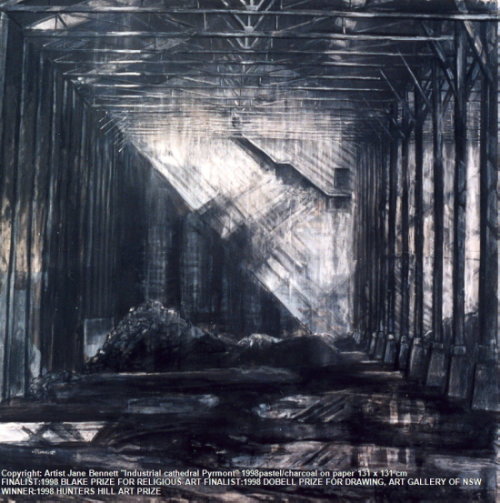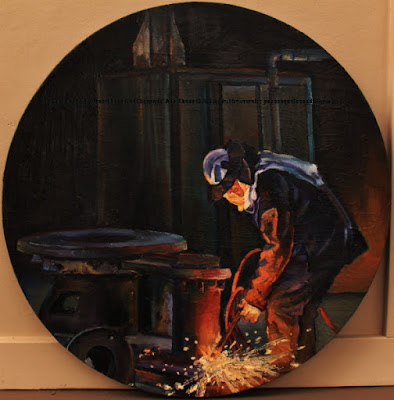Before the inevitable demolition of the Harbour Control Tower, I wanted to paint a very large panorama of this amazing view.
I'd had the run of the top floor and the amenities level of the 87 metre high Harbour Control Tower from the early 2000s until port operations finished there in April 2011. Afterwards I had occasional access to create paintings of various stages of the construction of Barangaroo.
I'd spent many unforgettable New Year’s Eves on the top floor, painting 360 degrees of the fireworks exploding underneath against the spectacular harbour view.
The perspective was very tricky, so I warmed up with a few smaller works first.
This is a small study of the rooftops of the heritage Miller's Point terraces and the former Bond stores of the Walsh Bay Wharves.

Work in progress " Miller's Point and Walsh Bay Wharves
from top of the Harbour Control Tower "
2014 oil painting on canvas 36 x 46cm
.
There was such an overwhelming mass of tiny
details that I needed to tackle this subject in a series of small works before
risking getting bogged down in a huge oil painting. I wanted to understand
the rhythm of the landscape.
The perspective is made more complex by the
landbridges over the twisting streets winding their way from the angled
rows of Walsh Bay Wharves up the hills.
The entire suburb of Miller's
Point lies at my feet and the roads seem to curve towards the Opera
House in the middle distance.
As you can see, my palette changed by the time I finished this work - one of the hazards of working 'en plein air'. I started early, but didn't finish for a few hours, so the clear pale yellows of the morning deepened to the burnt orange and rich purple shadows of the afternoon.
I had to stand on a chair to paint this, as the windows on the Amenities floor were a bit too high for me to see the terraces.
I'm only 5'1"- short, even for a woman.
Exactly the same height as Toulouse-Lautrec. Unfortunately I love painting canvases on an epic scale.
I had to stand on a chair to paint this, as the windows on the Amenities floor were a bit too high for me to see the terraces.
I'm only 5'1"- short, even for a woman.
Exactly the same height as Toulouse-Lautrec. Unfortunately I love painting canvases on an epic scale.
The tower would sway in
the wind, sometimes almost imperceptibly, and sometimes with a rolling
motion that can induce seasickness which is distracting when trying to
paint fine details.
In the far distance, you can see the silhouette of the half-demolished Hammerhead Crane on Garden Island, which was finally removed by October 2014. I had just finished a stint as 'Artist in Residence' on Garden Island painting this before the demolition started.
The demolition of the Harbour Control Tower would be next. However I did manage to finish a few large scale panoramas from the top floor, before I lost one of my best studios forever.
The State library now has several of these works in their collection.
Related articles
Related Posts








